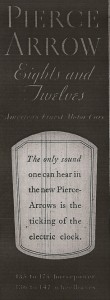
Copies.
These days there are a lot of copies running around our roads in the form of the grillwork of Ford cars.
You might have noticed.
The new grill design lifts Ford away from an indifferent look. It gives their cars panache and brio.
It adds oomph and an expensive bearing.
The new Fords gain in appeal because of it.
But I liked the Ford grill better in its original form.
On Aston Martin cars. They came up with it in the 1950s — I believe with their DB4 model.
Of course, Ford owned Aston Martin not so long ago.
Maybe that’s when the Aston Martin grill design made such an impression that it subconsciously re-emerged on new Ford cars.
Well, they say imitation is the sincerest form of flattery.
On that subject let’s move from Ford to Rolls Royce and a famous ad by David Ogilvy.
You probably studied it somewhere along the line:
‘At 60 miles an hour the loudest
noise in this new Rolls Royce comes from
the electric clock.’
Thirty years before, in the February 27th, 1933 issue of Time Magazine, the Pierce-Arrow car company ran this ad:
‘The only sound one can hear in the
new Pierce-Arrow is the ticking of the
electric clock.’
Both ads sold cars.

Yes, there are similarities, but the point is many learn from the past.
People take inspiration from what’s gone before. It’s a fact of life.
You can bet if an idea is good enough it will usually get picked up again and again.
That thought could be a starting point if you’re trying to improve the effectiveness of your email campaigns.
At a recent conference, a marketer asked how he could learn to write better copy for his email blasts.
He said he and his agency could use some ‘ideas that really work’.
The good news is a lot of thought has already gone into that area by an Advertising Hall of Fame Winner.
That’s John Caples in his books on direct marketing from the 1960s.
Read them, study them, consider the approaches he highlights.
You might be wondering … why look back to the 1960s for a better way to create a digital form of communication?
Strangely enough, not everyone realizes that email blasts are really direct response efforts.
These days they’re propelled by technology instead of stamps from the US Post Office.
So it pays to go back and learn about direct response techniques.
Techniques that have been tested over and over again to prove that they engage people and sell product.
This is summed up best by the direct marketing expert and author of many books on the subject, Drayton Bird.
He said something to this effect … ‘ways to communicate may change, but human nature doesn’t’.
Of course, he’s right. People are still human in 2014.
They respond to basic needs, desires and fears … to earn more, to improve themselves, to gain an advantage, to save money, to learn, to avoid difficulties.
So with motivations like these, John Caples is there for you with ideas on how to add power to your email campaigns.
Have a look at his book, Tested Advertising Methods.
Especially a section called ‘35 Headline Formulas’.
You’ll find they’re an effective way to learn to make your emails more engaging and pay their way with sales.
Use them as starting points for your thinking. Update and adapt them to your needs.
They’re a study in adding more purpose to your communications.
Okay, so we’re not exactly talking about original thinking here.
But we are talking about learning more and being able to profit more.
Share with us. How do you and your agency go about getting fresh ideas for your brand(s)? What books do you read? What conferences have been most helpful? Thanks for reading. Regards, Steve Ulin